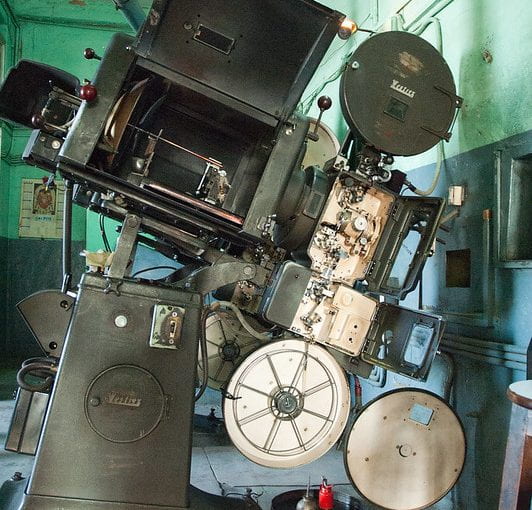A Day in My Life
Summary
A video where I take the viewer through an “average” day in my life. I recorded a day of my life minute by minute, leaving as little as possible missing. Then I converted the timestamps into percentages, and then put it into a pie chart, being sure to even include percentile of error. Then I created a script around the timestamps, and searched for images to include in a video. The video is about that day, and everything that happened during that.
Font
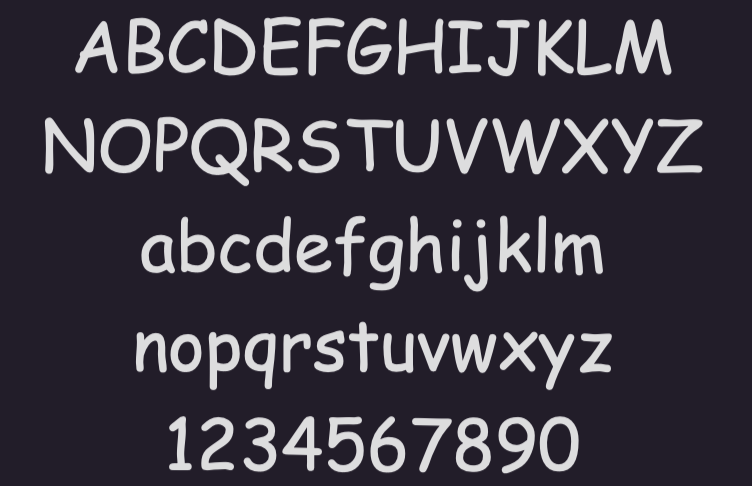
Color Palette
Dark Red 1: #D61910
Green: #4CFA32
Cornflower Blue: #4693D6
Dark Orange 15: #FA4F11
Green 11: #24D64A
Purple: #6B11FA
Blue 11: #0FD68F
Grey: #C0CFD6
Pie Chart
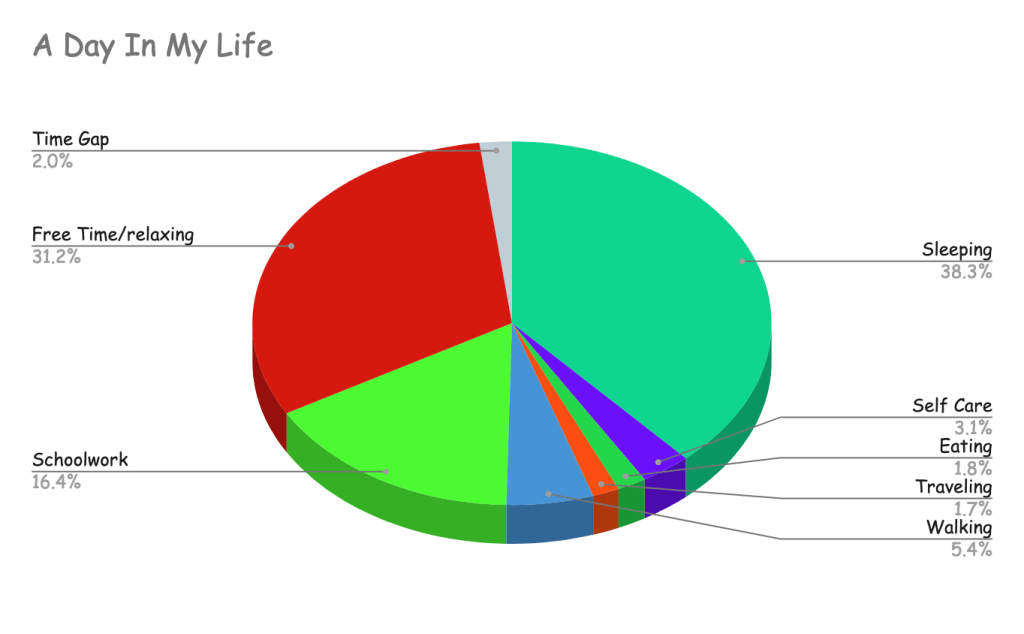
Script
12:00-7:14: Sleeping
7:15: Got out of bed
7:16-7:18: Got dressed
7:20: Took meds
7:21-7:34: Ran downstairs and paced
7:35-7:51: Ate breakfast
7:52: Ran upstairs
7:53-7:55: Brushed teeth
7:56-8:03: Used restroom
8:04-8:11: Ran around getting my stuff
8:12-8:24: Was driven to school
8:25-8:26: Arrived at school and walked inside
8:27-8:50: Began my daily walk
8:51-8:54: Went to 1st period
8:55-9:05: Paid attention to presentation
9:06-9:17: Presented my presentation
9:18-9:39: Continued to pay attention to presentations
9:40-9:44: Walked outside for evacuation drill
9:45-9:59: Waiting to go back to class
10:00-10:11: Walked back to class
10:12-10:37: Played UNO
10:38-10:41: Walked to 2nd period
10:42-11:18: Began work and listened to teacher
11:18-11:22: Walked to 3rd period
11:23-12:00: Paid attention to group therapy
12:00-12:02: Walked to 4th period
12:03-12:30: Worked on math
12:30-12:43: Socialized
12:43-1:12: Played video games & talked with BF during lunch
1:13: Walked to 5th period
1:14-1:54: Worked on late work
1:55-1:56: Walked to 6th period
1:57-2:35: Worked on crazy board while watching a movie
2:36-2:40: Walked BF to bus
2:41-2:44: Walked to fathers class
2:45-3:33: Relaxed and listened to music
3:34-3:50: Worked on homework
3:51-4:03: Driven home
4:04-5:34: Relaxing and listening to music while working on homework and eating dinner
5:35-7:00: Played video games
7:01-7:09: Waiting while texting
7:10-9:30: Watched tv with my father
9:31-10:01: Showered, brushed teeth, and went to bed
10:02-12:00: Sleeping
Audio Editing
Storyboard
Video Editing
The Documentary
What I Learned and Problems I Solved
I learned that I need to learn how to balance projects instead of prioritizing ones from specific classes.
Cookie Jar Post-Production Project

SUMMARY
Once production finished, I had nothing to do but work on my blogs and gather evidence for blogs and the team slideshow.
Evidence of Further Contribution
I did not contribute anything further to the film due to being very limited in my ability to assist after the film was finished. The only project I could work on was the presentation and my previous blog posts for the session.

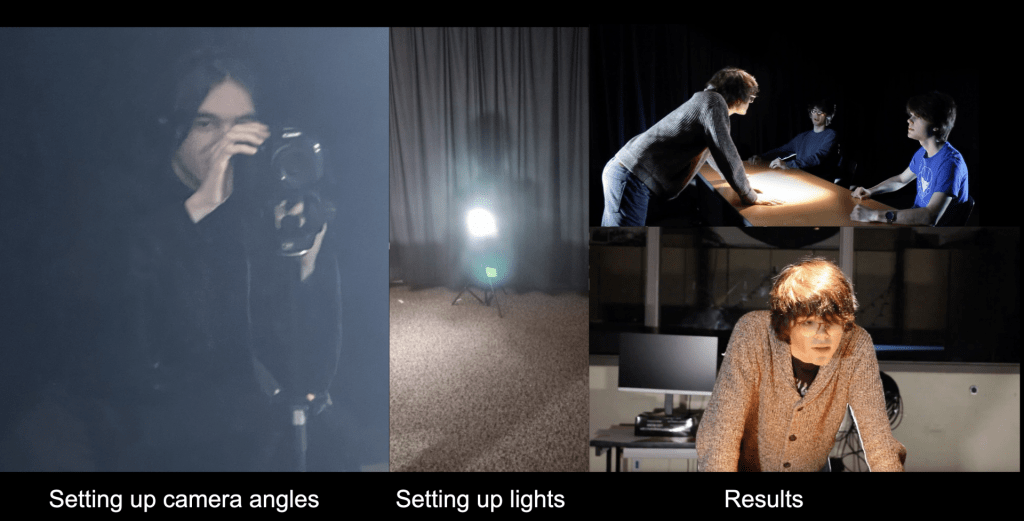


How I Could Have Improved The Film
I could have been more involved during production and should have micromanaged my role more. Additionally, I feel that I should have mentioned multiple little angle and lighting details that bothered me that could have improved the quality of the film. There were a few times where it was obvious that there were lights behind each of the actors, which I didn’t like. I wish that the lights were situated more efficiently.
What I Learned
Contributing after production is very difficult, and I also feel that I could have done a better job as cinematographer. I could have taken more control and worked on an equal ground with the director in terms of scene control. I could have made more independent decisions.
Who took the cookie from the cookie jar production project

Summary
I set up lighting, moved equipment, set up cameras, adjusted shots and lighting to fit the scene, and did other things to affect visuals.
Camera Evidence
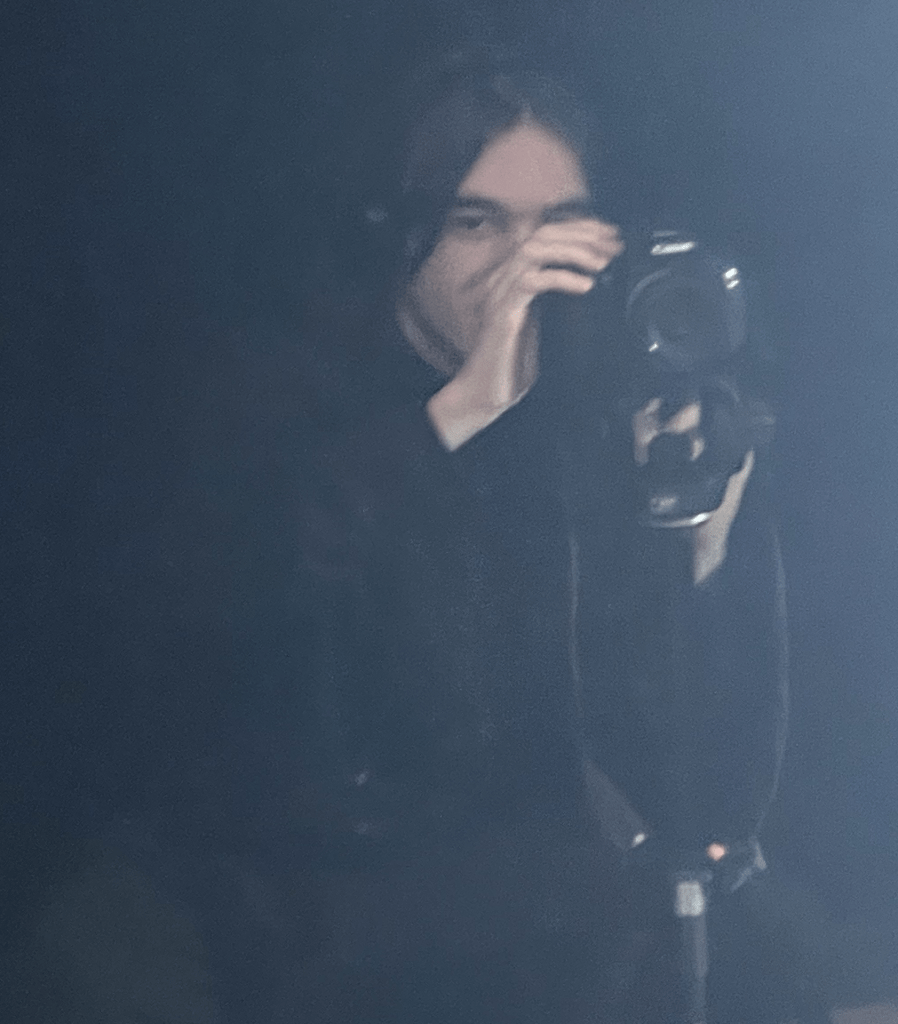
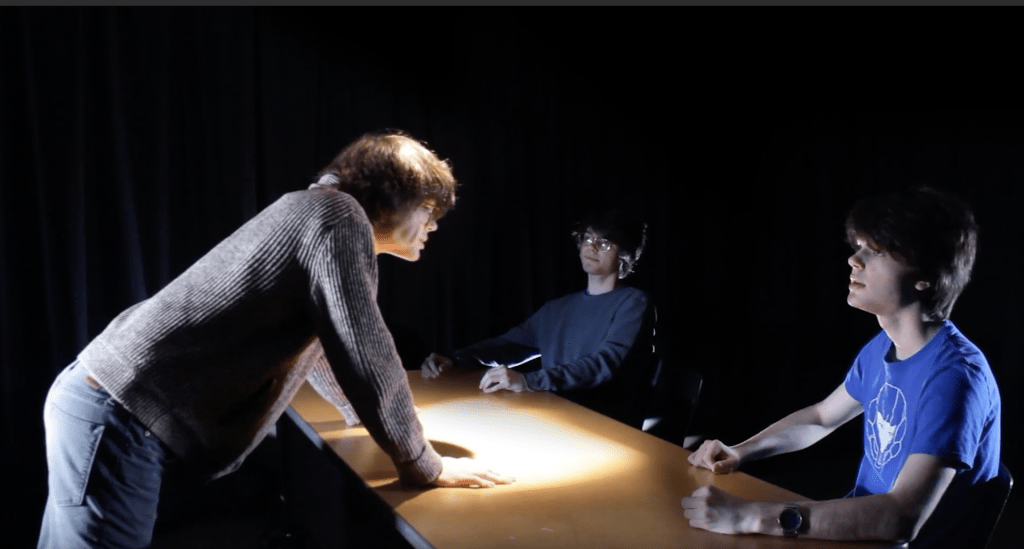
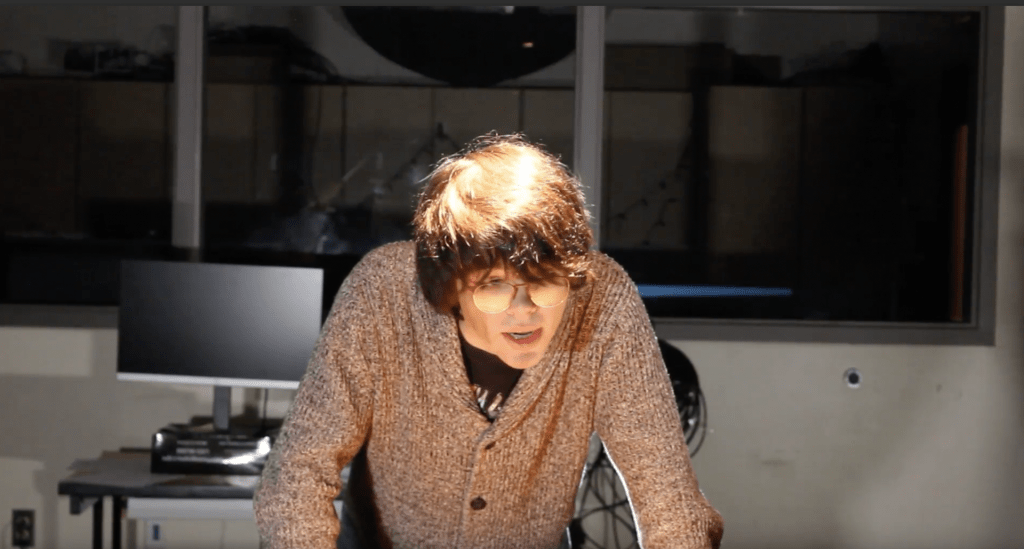


Shot Choice Justification
Our wide shots were to set the scene and to use blocking between the actors. Our single or double shots were to emphasize the importance of the dialogue and to have the audience focus on one character specifically. Lastly, our closer shots amplified visible emotion and increased tension.
Lighting Design
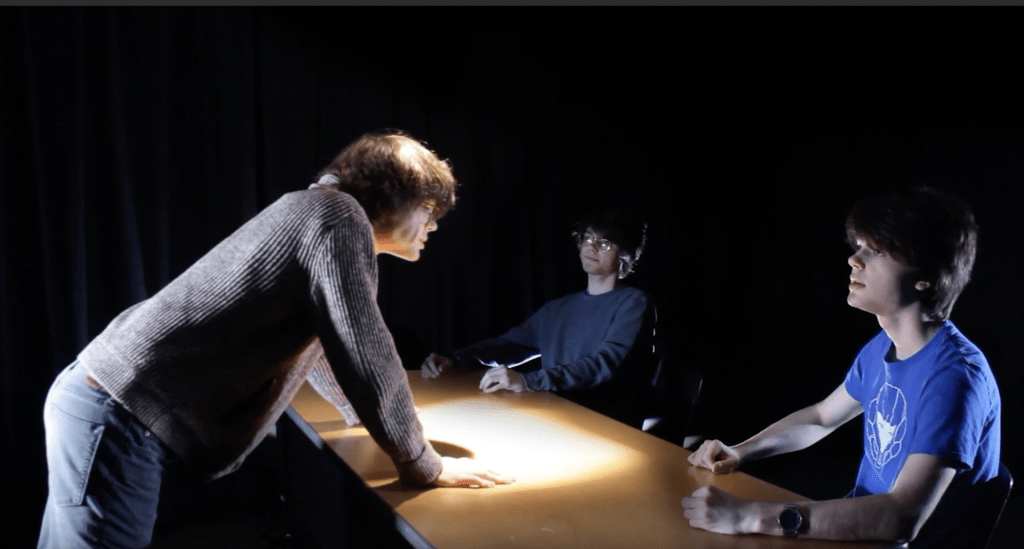
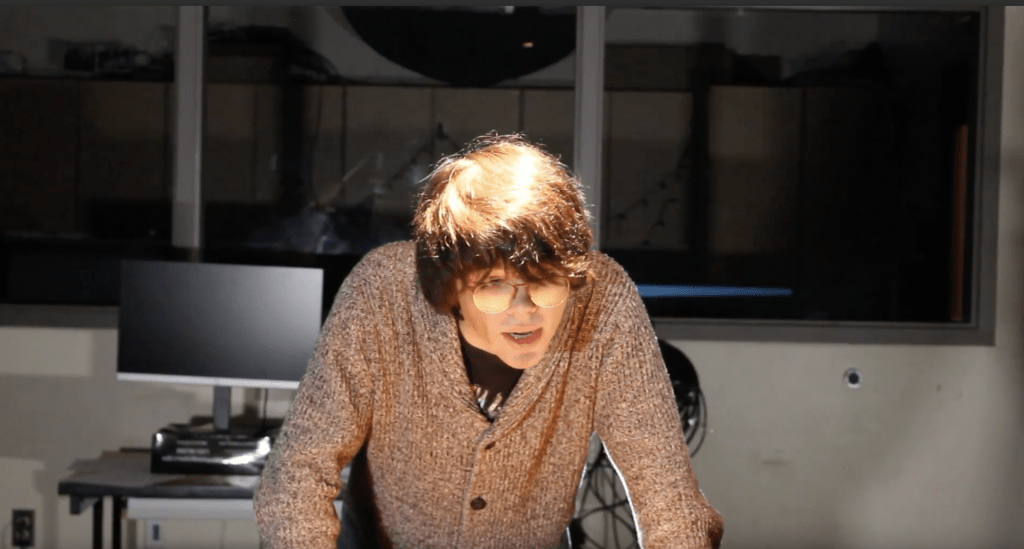
Consultation with Editor
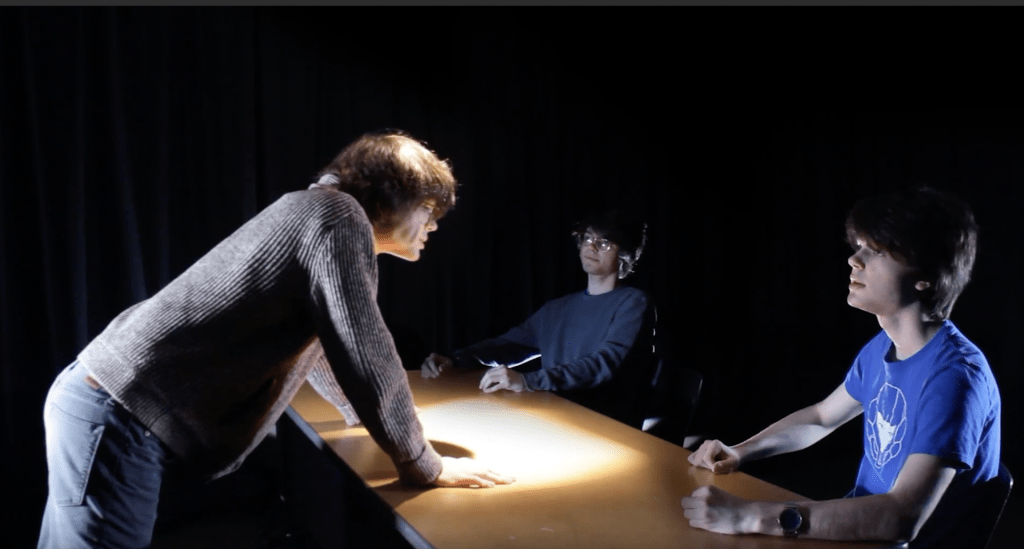
Alternative Shots

Camera Work and Lighting Evaluation
The lighting was simple to set up. It was basic math, setting up the light so that they made the actor perfectly visible, but the light itself was not visible to the camera. I was able to make use of multiple lights provided to me. Additionally, the camera angles were complex, so I had to be sure I was precise as possible in setting it back up in between shooting dates.
Influences from Films

What I Learned and Problems I Solved
Being a Cinematographer is challenging, and there is little you can do after production to help your crew. The job is simple on paper: record scenes, make small adjustments, and overall listen to your director, but I had to micromanage so many things that would have seemed inconsequential to me before.
Who took the cookie from the cookie jar Cinematographer Pre-production Journal
Summary
We managed future work on our Trello board and talked about the film. I created and then completed my mood board. We found a filming location and worked on test shots. We rehearsed scenes, filmed shots, and recorded sound. Every day after recording sound and visuals, we downloaded them to send to our editor, who kept them to use to make the final product.
52. Wide-Angle
58. Close-Up
60. Two shot
Test Shots
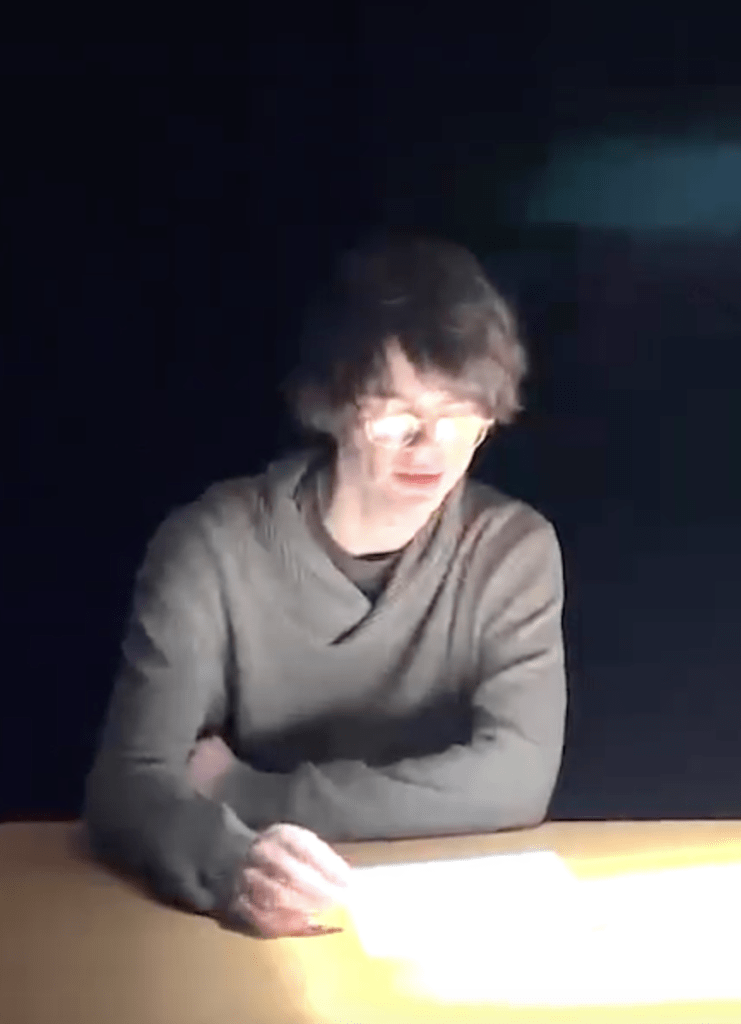
I used these two different lenses, one changes length, and the other changed focus. We started out with very primitive test shots and adapted to suit the room.
Lighting Tests
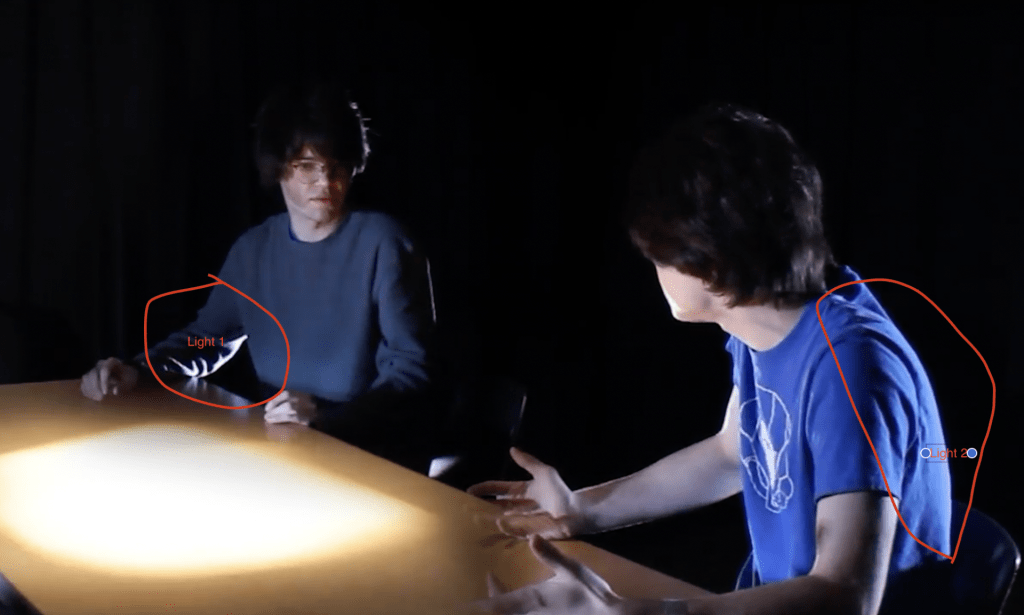
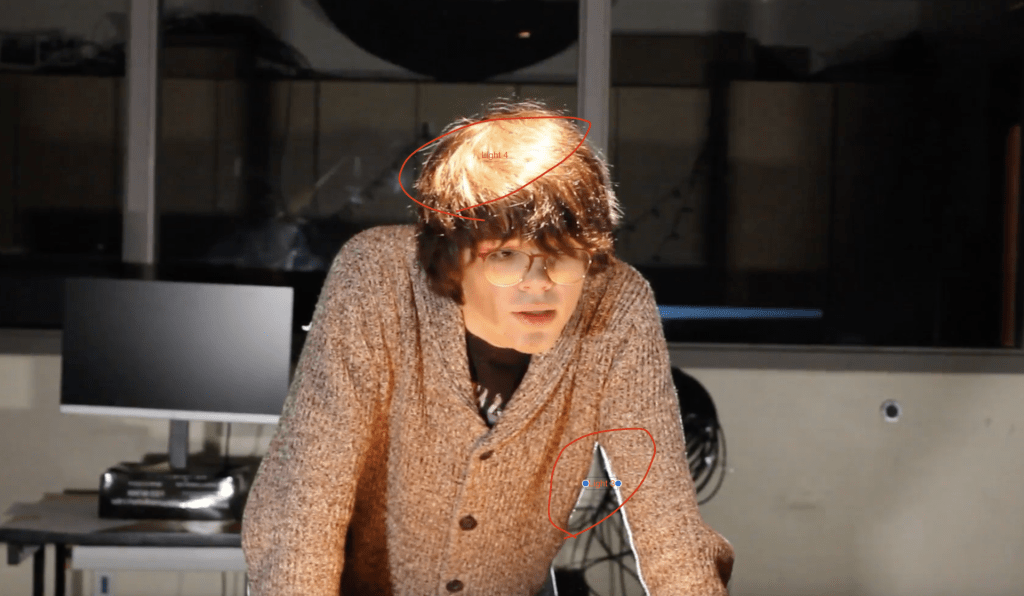
Equipment Checklist
- Camera
- Tripod
- Audio recorder
- Boom mic
- Lighting block x3
- Shot list
- Script x2
Collaboration with Director


Set-up Sequence Workflow
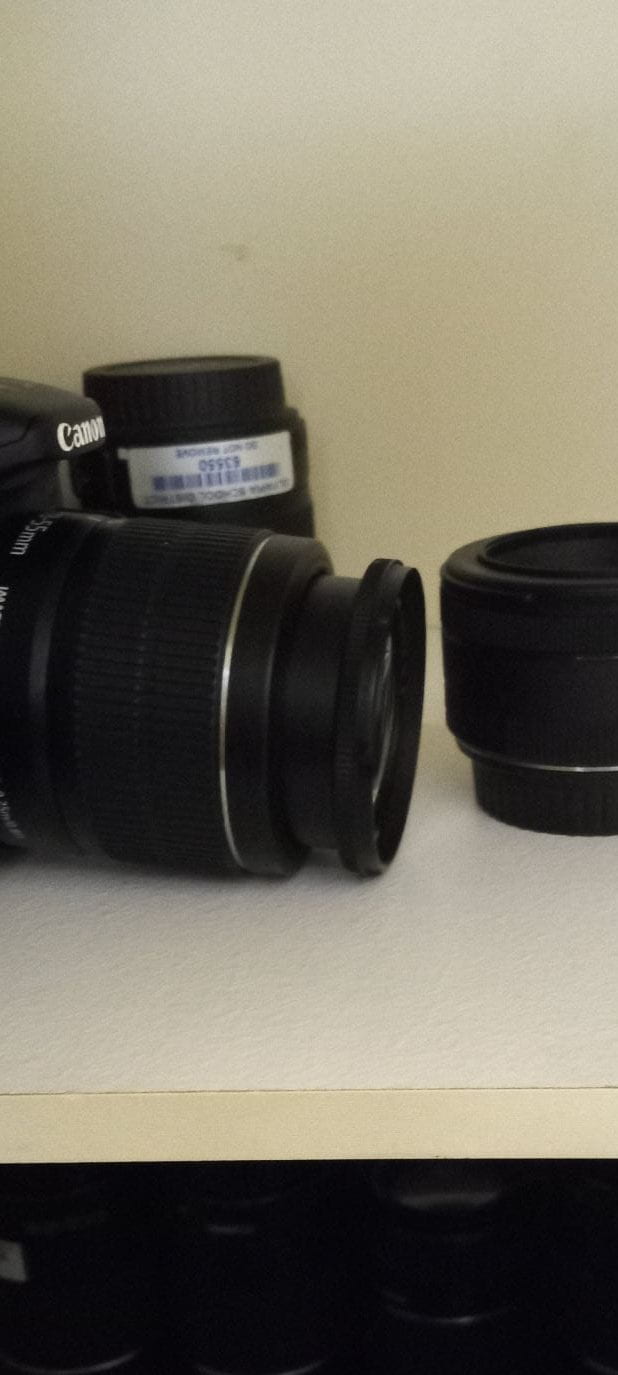


Map of Each Location
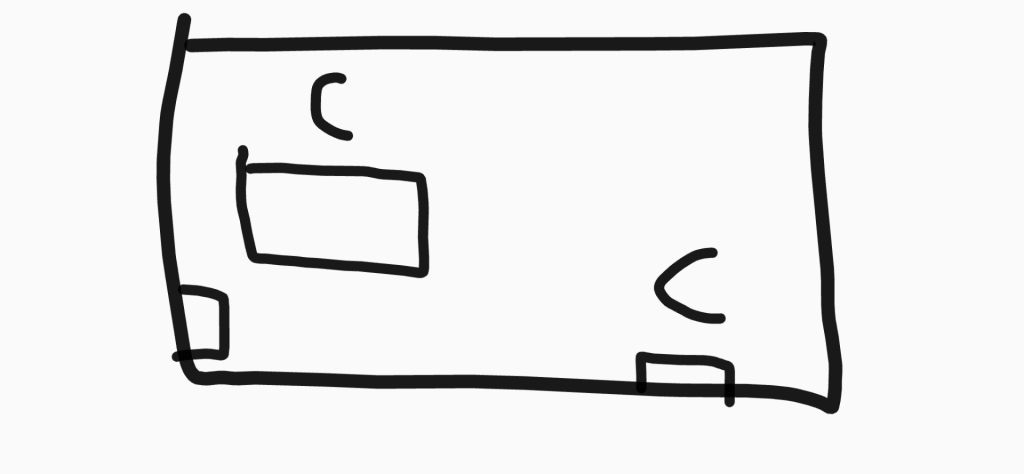
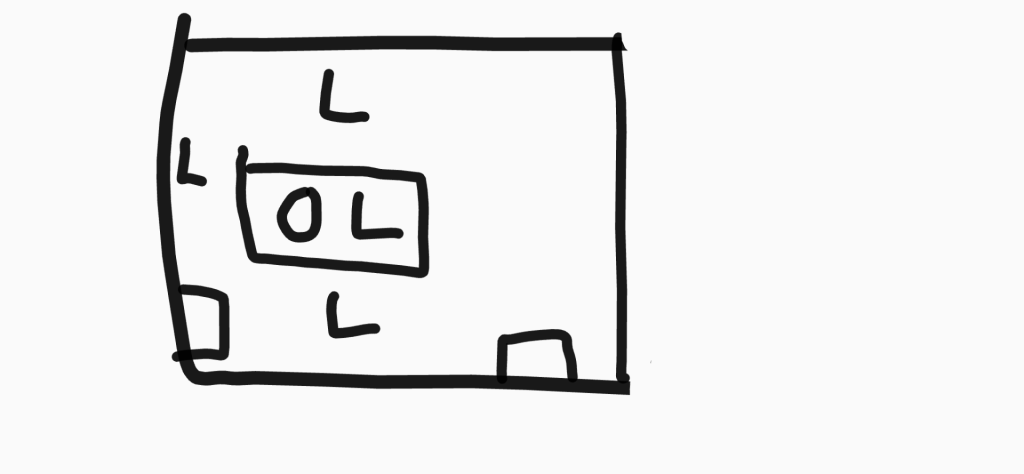
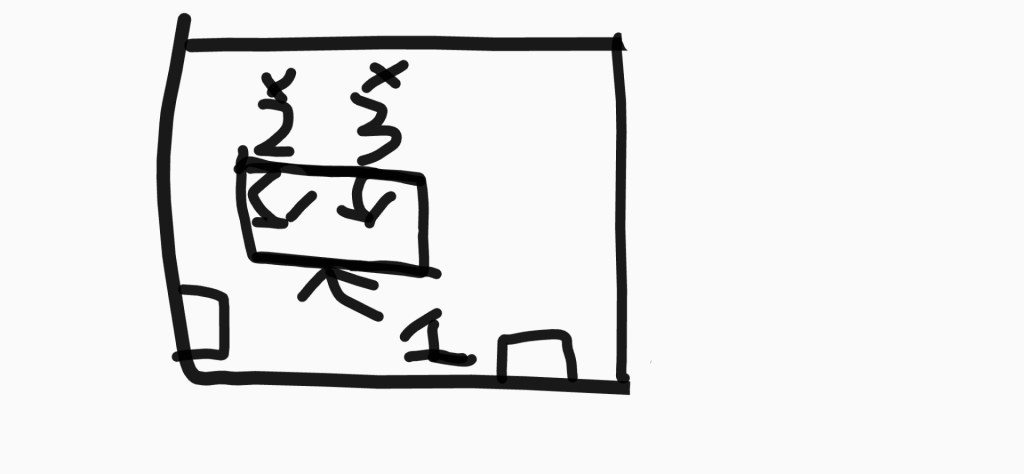
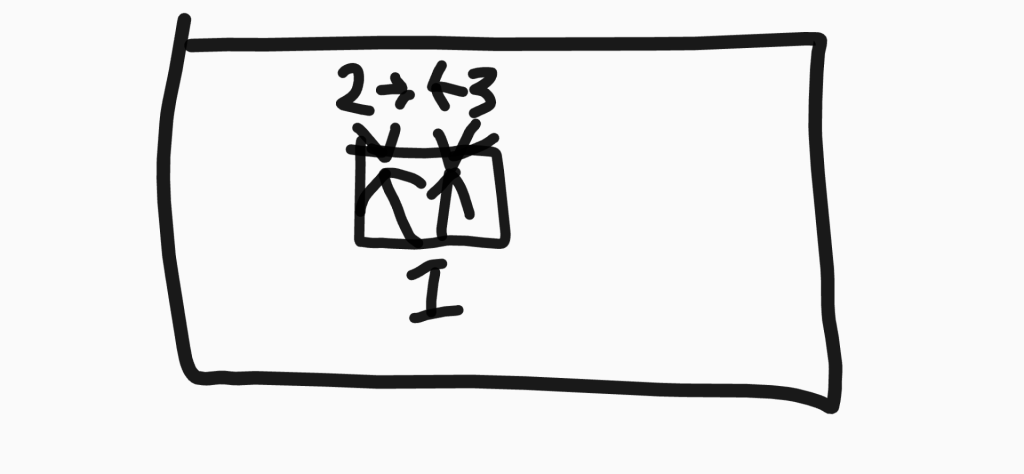
Storyboard Notation
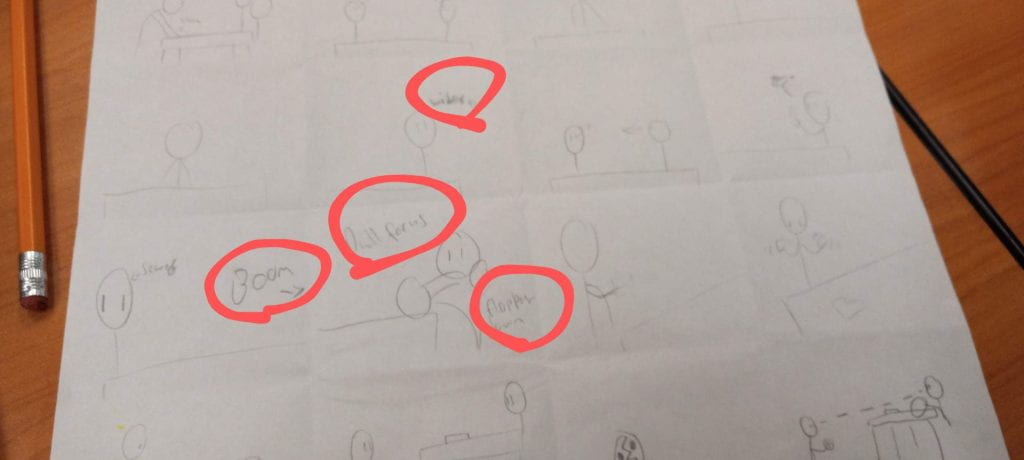
What I learned
I learned that I need to get more evidence of me doing my job instead of doing my job. A problem I solved was using camera angles to make up for a lack of actors during the assignment where we had to record a rough draft of a rough draft of our film without editing.
5/8-5/12 Weekly Work Log
| Session Number: 5 | |
| Week Number: 6 | |
| Total Estimated Hours Contributed this Week: | |
| What was your overall goal for this week? Contribute to the group even though the film is complete |
Work Tasks
| Date | Task Description | Time Spent | Was this a Best Practice? |
| 6/5 | Worked on Day of My Life (Chart) | 50 min | Not exactly, I got work done, but it wasn’t my best work. |
| 6/6 | Worked on Day of My Life (Chart) | 50 min | Yes, I got so much work done. |
| 6/7 | Worked on Day of My Life (Blog) | 30 min | I didn’t have as much time, so no. |
| 6/8 | Worked on Day of My Life (Blog & Script) | 3 min | I had to watch videos with the class today, so I didn’t have lots of time to be productive. |
| 6/9 |
Personal Comments (Optional)
Are there any other comments you would like to include? If so, please enter them here:
Someone or Thing Fighting Someone of Thing for Someone or Thing Pitch’
- FILL IN ALL SECTIONS BELOW
- DELETE ALL OF MR. LE DUC’s Italic INSTRUCTIONS AFTER COMPLETING THEM
LOGLINE
Man chased by scammer serial killer.
PROTAGONIST
Average “normie”
PROTANGIONST CORE WOUND / MOTIVATION
Keeping both his money and his life
GENRE
Horror
Halloween + Friday the 13th
PLOT DESCRIPTION
Man lives out his daily life once. The next day, the main starts seeing a man following him and watching him. The main starts having panic attacks as the man gets closer and closer each time. Soon, pursuit begins, and no one stands in the man’s way. The main is chased all the way back to his home, where the man breaks inside with ease and is about to kill the main, but then say; “Hello, we’ve come to reach you about your cars extended warranty.” The man then stabs the main to death and takes the car keys, leaving a service card and a pamphlet behind.
TREATMENT
Extroverted “normie” with typical friend group and social life. Middle class and well paying job.
- Complete a paragraph describing the protagonist’s world
- This description helps the team build a better, more believable world
- You may include wardrobe, family, friends, food choices, habits, hang-ups, etc.
INFLUENCES and EXAMPLES
- List directors or other filmmakers FROM YOUR CHOSEN GENRE you are using for research and inspiration
- List scenes FROM YOUR CHOSEN GENRE you are using for research and inspiration
- Embed video clips of scenes that may influence or inspire stylistic choices in your film
Production Project #4
SUMMARY
Role
Director
Intention (SMART Goal)
By March 1, as Director, I will have evidence of managing actors, utilizing time efficiently, and cooperating and communicating with the set crew by following “Fincher on Fincher” for Session 4.
PRE-PRODUCTION – INQUIRY
Leader(s) in the Field / Exemplary Work(s)
The Social Network (2010) – IMDb: David Fincher
Things I noticed about directing:
- The development of characters, especially Mark, was very interesting.
- Cinematographer choices with angles, panning, lighting, and scene swaps were intentional and attention-grabbing.
- The emotions or lack of emotions were depicted very well.
- The intensity and some of the decisions of the characters was very interesting.
- The dialogue was very important and the characters interacted very realistically.
- Power dynamic shook the film a lot.
- The dynamic of the twins was very fascinating and unique
Training Source(s)
- Create the scene before setting up the camera angles. 3:19-3:51
- When two people meet for the first time, have them be even in the shot, but when one has more power, make them larger and have them take up more space in the shot, when one has less, make them smaller and have them take up less space. If they have equal control, make the shot evenly spaced between them. 4:02-5:01
- Make sure to have characters motivate camera movement to keep the scene active. 5:04-5:38
- As a general rule, follow the story of your film. Other takes on the script can be interesting, but keep it true to your vision. 5:42-6:18
- Do not be afraid to do multiple takes, and it will take time to become comfortable with requesting more takes. 6:19-7:04 & 8:34-9:26
- Mold the actors into the role. Make the actors identical to their character. 7:10-7:49
- Keep emotions consistent with the character and the story’s mood. You can also see more subtle flaws in emotion after having done multiple takes. 10:04-10:42
- Add variety to scenes and keep the audience focused. Remove distractions. 10:44-11:15
- You need to get exactly what you want from every member of the crew. 11:20-12:14
- Move people around according to what the scene needs. Keep actors in line and organized. 12:15-13:41
- Colors are attached to the mood of the scene. Pink is associated with happy and healthy people, destroy that concept as often as you can. Green is a good color for showing tension and drama in a scene, or it could be used to show empty characters. Yellow is a good color for darker shots and scenes, and obstructs your view of the actors. 13:43-15:57
- Creating a feeling throughout the audience is important. 15:49-16:07
- Good production designers don’t talk about the cost, but about the feeling they will evoke in the audience. 16:08-17:13
- Music can be changed to fit a scene. Being creative with music can create a better result. 17:13-17:48
- Creating a feeling for the setting from anything from design choices to content is very important. 18:08-19:02
Project Timeline
- Communicate thoughts, goals, and expectations
- Planning schedule and resources
- Create a functional script and a final storyboard
- Establish full rough draft of the script
- Practice and record test shots
- Begin filming and listen to recommendations for adaptation
- Be sure to pack up the set after filming
- Be sure to download ALL RECORDINGS from the camera
- Allow the editor and director some time to review the recordings
- Repeat steps 6 through 9 until you are satisfied with all the final shots
- Allow the editor to piece the final film together and help in any way that you can.
- Review the final film with the crew and if satisfactory, the director will sign off on it. If it isn’t satisfactory, the director will sign off on it anyway, because there won’t be enough time to change anything unless it’s in the editing phase
Proposed Budget
None
Evidence of Team Planning and Decisions
PRODUCTION – ACTION
The (FILM, SOUND, or GAME Creation)
Skills Commentary
I utilized time efficiently with improvements throughout development. I managed actors acceptably, but not to my liking, so I need to improve that. I communicated with my crew consistently, but it was not as effective as I would have hoped. Actor management can be seen on the right in the call sheets in my organization of their schedules. Time utilization can be seen in the middle, which shows part of the trello board I chose to ignore. Communication with crew can be seen on the left in the notes I left for the crew.
POST-PRODUCTION – REFLECTION
21st Century Skills
Ways of Thinking (Creativity, Innovation, Critical Thinking, Problem Solving)
When our schedule was disrupted, we were able to change the plan quickly and effectively. We managed to make creative decisions that saved time for editing.
Ways of Working (Communication & Collaboration)
We made choices and discussed them before taking action. All viewpoints were considered, and we went for the more effective options in a timely manner. Unfortunately, we were not always clear in our instructions or suggestions, and we need to work on that.
Tools for Working (Info & Media Literacy)
I used my knowledge of campus to explore different options for filming locations, and I used the video to help me become more comfortable with retakes.
Ways of Living in the World (Life & Career)
I not only learned about myself, but I also learned that in order to have enough time to edit, not only do we need to finish filming sooner, but we also need to manage our organization and schedule more effectively, because we all can improve that.
Reactions to the Final Version
Although there was very little feedback for me from the professionals, there were a few peers who suggested changes. My decisions need to be more organized and sensible (such as the clock time patterns and moments without context).
Self-Evaluation of Final Version
I feel that we are improving and growing as a team, but we still have a lot we can improve. Our management of time, our communication, and simple mistakes and accidents which can or cannot be avoided hindered our project significantly.
Grammar and Spelling
Grammarly and spell check
Editor
Zac
Favorite Director
Who is one of your favorite directors
Director’s Name: Irvin Kershner
Link to their IMDB.com page: Link
Video essay link or embedded YouTube clip about the director or their directing style: https://www.youtube.com/watch?v=SVlXXwCIUiQ
Notes About What Makes Their Style Unique
He is very vocal and doesn’t work the actors into the role. He let people improvise so that the movie could work. He had a lot of freedom which allowed him to be more creative with making the film.
Production project: Session Three
SUMMARY
Role
I am the director for team one
Intention (SMART Goal)
By January 13th, as director, I will have evidence of applying myself to the production, managing the crew more efficiently, and improving my skills in directing by following “How to Shoot Effective Scene Coverage” for session three.
PRE-PRODUCTION – INQUIRY
Leader(s) in the Field / Exemplary Work(s)
Steven Spielberg
Notes: Number 1 is story, and choosing specific themes. Ordinary people in extraordinary circumstances are difficult to pull off, but wonderful when done correctly. 2, production design focuses on putting characters in extraordinary circumstances which are larger than themselves. To grasp the understanding of the audience, scale can be used to help them understand the situation. Crowds can create more intense panic, and threats should be depicted as massive, bigger than anything around it. Sets will be massive to show how much bigger the situation is than the character. 3, color can establish tone, transport the viewer to a fantastic new world, or to attract attention. Color can help the viewer feel what the characters are feeling if used correctly. Color can also be used to attract attention on something or someone specifically. Brightness can heighten the extraordinary nature of something in a scene like magic or a spaceship. Tone can be defined through saturation and dim vs bright. Color can attract the audiences attention. 4, cinematography can be used with variety. Smooth vs gritty should depict different settings and tension levels. Silhouettes, reflections, and shadows are special cinematography choices. The moving camera should be one of the most dominant techniques, which is used in order to keep the audience focused on the extraordinary journey. The camera should be an active participant and make the viewer feel present in the scene. Moving camera can create layered blocking along with multiple shown areas in a single shot. Framing in long takes should always be changing, and this can be used to shift the attention of the audience in between different things. Long takes can be used to sustain momentum in action scenes. 5, editing should be designed to go unnoticed to keep the audience immersed, and focus on emotions can create tension in the audience. Editing can keep the viewer connected to the emotion and plot. Geography is highly important in order to keep the audience out of chaos. Suspense can be created when the audience knows where the threat is. Cuts should shift in size consistently. 6, sound can be great for telling an additional story, and can serve many functions. Sounds of clocks can add stress and remind the audience of the lack of time. Dynamic sound should have big and small sounds mixed together to keep the audience on the edge of their seats. Sound can guide the storytelling, and sounds above soundtrack in suspenseful scenes can create a bigger feeling of suspense and for contrast. Quiet can be used to establish a presence using obvious quiet sounds and character silence. And abrupt interruption of silence makes a threat just that much larger. Unique sounds can also go a long way, can can even be used to establish a presence of power and authority. Sound should contrast between quiet and loud, and can be used to create emphasis onto what matters in a scene. And 7, music
Training Source(s)
How to Shoot Effective Scene Coverage
Notes: Takes should be taken in their entirety from one angle to and then try to cover as much of it as possible from each camera angle. Allow actors time to rehearse and become comfortable in their role. Be prepared to make changes to the script. Master shot to close up can be very important. Master shot: Most important action in scene. Close ups: To see actors. Having a variety of shots allows the director to be able to make decisions in the editing bay rather than on set. Varying shot size can increase the amount of coverage. Tightening shots can be useful to increase coverage without moving the camera.
Project Timeline
None
Proposed Budget
None
PRODUCTION – ACTION
The (FILM, SOUND, or GAME Creation)
Skills Commentary
My job during production was management of the crew, set, actors, props, and the film itself. My responsibility is being present, both physically and mentally, at all times during production, and keeping safety as a number one priority. Whenever a change was made, I was required to approve it. My goals for this session were not only developing my skills at managing the film, but also at managing my time and using effective communication, which I feel I have improved upon. As Director, I have to locate and obtain usage permission of an area to use as a set, monitor the transportation of all equipment and crew members to the location, manage and advise upon different decisions and changes to the film, monitor the return of equipment and ensure the set is the way we found it, ensure the camera and audio files are properly accessible to the editor, and then ensure that all equipment returns to their respective storage areas.
POST-PRODUCTION – REFLECTION
21st Century Skills
Ways of Thinking (Creativity, Innovation, Critical Thinking, Problem Solving)
I was more flexible and patient when solving a problem, and we were able to manage our time effectively and creatively. When considering suggested additions to content, I put thought into which decisions were brought into the film, and which ones didn’t fit or were not appropriate to the scene.
Ways of Working (Communication & Collaboration)
I communicated with my team to understand what they needed from me and to address what I needed from them. We were able to discuss what we were working on and what other team members could do to assist, and we were typically able to work on other things if we couldn’t help anyone else.
Tools for Working (Info & Media Literacy)
I was able to use my knowledge of acting, spacing, blocking, etc. to shape the film to appear more fluid and realistic.
Ways of Living in the World (Life & Career)
I learned more about collaboration and the struggles of a director. I developed my skills in keeping people focused on the project. I utilized my time and I have improved my time management and organization.
Reactions to the Final Version
The beginning had a singular missing shot which included context to the situation, which caused general confusion. Cinematography was organized and efficient, and used techniques effectively, however, there could have been more creative expansion. Editing was fluid. No feedback for sound director or director. “I feel that the cinematography could have been expanded on more creatively.” -Advisor
“The lighting noticeably fluctuated from shot to shot.” -Peer
Self-Evaluation of Final Version
The film itself was very straightforward and clear about what the purpose was. The film was very confusing in the right aspects which was meant to catch the audience off guard and make them think. Sensory language was limited. No outside credibility. Frustration was expressed properly along with confusion, however, I feel emotion could have been improved upon. Stimuli and motive have been provided and built upon, however, they were both limited.
What I learned
The Directing of the film was highly dependent on communication rather than instruction. I was able to effectively communicate how I felt the time should be used, and also was able to ask what the other crew members needed. As for managing authority and focus, distraction was inevitable, and even though we lost focus from time to time, I feel I was effectively able to refocus the group back onto the film relatively quickly. The only area I feel I was lacking was my management of the editor. During the editing phase, there was very little I could do to assist or further instruct any of the crew, and due to the lack of time flexibility, my editor hardly had the time or focus to dedicate his time effectively to the film had I been consistently looming over his shoulder.
Grammar and Spelling
Grammarly and spell check
Editor
Samara N.
Film Analysis:
- Josie’s analysis of One Flew Over the Cuckoo’s Nest
- Lindsay’s analysis of 6 Underground
- Stuart’s analysis of Ford vs. Ferrari and Greenland
- Naomi’s analysis of 13 Going on 30
- Robbie’s analysis of Gojira (Orginal Godzilla) and Space Battleship Yamato 2199
- Malachi’s analysis of Ratatouille
- Giovanni’s analysis of Iron Monkey
- Avery’s analysis of Just Mercy and Terminator 2: Judgement Day
- Meredith’s analysis of Mother
- Jaden’s analysis of Baby Driver
- Reese’s analysis of Paul Blart: Mall Cop
- Cooper’s analysis of Die Hard, Bird Box, Forrest Gump, Finding Nemo, Toy Story 3, Wonder, and The Blind Side
- Katherin’s analysis of Bedtime Stories
- Jack’s analysis of Clone Wars
- Francis’ analysis of The Sound of Music
- Eli’s analysis of Green Book
- Avian’s analysis of Knives Out and Notes on a Scene of Memento
- Jakob’s analysis of Indiana Jones: Raiders of the Lost Ark
- Isaac’s analysis of Ratatouille
- Aidan’s analysis of Jaws
- Nick’s analysis of Marvel Movies
- Dylan’s analysis of Toy Story 4, Avengers Endgame, The Adventures of Sharkboy And Lavagirl, and Spiderman Far From Home, Despicable Me, and Black Panther
- Jacob’s analysis of Death Race: Beyond Anarchy
- Nolan’s analysis of Transformers: Revenge of the Fallen
- Coletrane’s analysis of American Psycho
- Will’s analysis of The Conjuring and 2022 Batman
- Kyle’s analysis of Breaking Bad
- Adia’s analysis of Leon the Professional
- DELETE ALL OF MR. LE DUC’s ALL UPPERCASE INSTRUCTIONS DETAILED ABOVE
Summary
- IN ONE TO TWO SENTENCES, DESCRIBE WHAT FILM YOU ANALYZED FOR THIS PROJECT AND WHY YOU CHOSE IT
- DELETE ALL OF MR. LE DUC’s ALL UPPERCASE INSTRUCTIONS ABOVE
Film Analysis
| Film Title | PLACE YOUR RESPONSES IN THIS COLUMN (DELETE THIS MESSAGE BEFORE YOU WRITE) |
| Year | |
| Director | |
| Country | |
| Genre | |
| If you could work on this film (change it), what would you change and why? |
Film information can be found at imdb.com
As you view films, consider how the cuts, camera angles, shots, and movement work to create particular meanings. Think about how they establish space, privilege certain characters, suggest relationships, and emphasize themes. In addition to shot distances, angles, editing, and camera movement, note details of the narrative, setting, characters, lighting, props, costume, tone, and sound.
Ask yourself the following questions:
| TOPIC | YOUR NOTES |
| 1. Who is the protagonist? | |
| 2. Who is the antagonist? | |
| 3. What is the conflict? | |
| 4. What is the theme or central, unifying concept? (summarize in one or two words) | |
| 5. How is the story told (linear, non-linear, with flashbacks, flash-forwards, at regular intervals) | |
| 6. What “happens” in the plot (Brief description)? | |
| 7. How does the film influence particular reactions on the part of viewers (sound, editing, characterization, camera movement, etc.)? Why does the film encourage such reactions? | |
| 8. Is the setting realistic or stylized? What atmosphere does the setting suggest? Do particular objects or settings serve symbolic functions? | |
| 9. How are the characters costumed and made-up? What does their clothing or makeup reveal about their social standing, ethnicity, nationality, gender, or age? How do costume and makeup convey character? | |
| 10. How does the lighting design shape our perception of character, space, or mood? | |
| 11. How do camera angles and camera movements shape our view of characters or spaces? What do you see cinematically? | |
| 12. What is the music’s purpose in the film? How does it direct our attention within the image? How does it shape our interpretation of the image? What stands out about the music? | |
| 13. How might industrial, social, and economic factors have influenced the film? Describe how this film influences or connects to a culture? | |
| 14. Give an example of what a film critic had to say about this film. Use credible sources and cite sources. Example: “The Shawshank Redemption Movie Review (1994) | Roger Ebert.” All Content. N.p., n.d. Web. 24 June 2015. | |
| 15. Select one scene no longer than 5 minutes that represents well the whole film and shows relevant cinematic elements. Write a one-sentence description of the scene and record the time of the scene. Example: from 1:05:00 to 1:10:00. Explain why you chose this scene. | PLACE THE TIME STAMP FROM THE SCENE HERE… Example: 00:00:00 – 00:05:00 |
| 16. In the selected scene: write a sentence for each of the elements below to justify why this scene best represents the film: | |
| a. Screenwriting: | |
| b. Sound Design: | Sound effects were consistent and clear. Every time an actor moved in the area of garbage, you could clearly hear the sounds of bottles, broken glass, paper, garbage cans and garbage can lids. |
| c. Camera Movements/Angles: | When they were arguing, it showed individual frames to show that they were not on the same side, but when they calmed down and seemed to show respect for each other, it showed them both from the side, representing how they see each other and treat each other as equals. |
| d. Light Setup: | The lighting was perfect for the setting and time, and there were many different little pockets of smoke coming from the diner showing that it had been successfully put out recently. The lighting in the diner also made it seem more dead and dull. There was a giant shadow over the front of the diner at the very end, while the rest of the town was bright, showing that the diner had no place in the neighborhood anymore. |
| e. Soundtrack/Score: | The music tone fit the dialogue perfectly and became more cheerful and triumphant as the story took a more uplifting turn |
| 18. What’s the socio-cultural context of this film? |
This worksheet was developed with ideas from many IB Film teachers, thus should remain in the Creative Commons

